Investigation of Layered Structure Formation in MgB2 Wires Produced by the Internal Mg Coating Process under Low and High Isostatic Pressures
Abstract
1. Introduction
2. Materials and Methods
3. Results and Discussion
3.1. Structural Analysis of MgB2 Wires
3.2. Irreversible Magnetic Field Analysis for MgB2 Wires
4. Conclusions
Author Contributions
Funding
Institutional Review Board Statement
Informed Consent Statement
Data Availability Statement
Acknowledgments
Conflicts of Interest
References
- Yagaia, T.; Mizunoa, S.; Okuboa, T.; Mizuochia, S.; Kamibayashia, M.; Jimboa, M.; Takaoa, T.; Hiranob, N.; Makidac, Y.; Shintomic, T.; et al. Development of design for large scale conductors and coils using MgB2 for superconducting magnetic energy storage device. Cryogenics 2018, 96, 75–82. [Google Scholar] [CrossRef]
- Ballarino, A.; Flükiger, R. Status of MgB2 wire and cable applications in Europe. J. Phys. Conf. Ser. 2017, 871, 012098–0120105. [Google Scholar] [CrossRef]
- Parizh, M.; Lvovsky, Y.; Sumption, M. Conductors for commercial MRI magnets beyond NbTi: Requirements and challenges. Supercond. Sci. Technol. 2017, 30, 014007. [Google Scholar] [CrossRef] [PubMed]
- Buzea, C.; Yamashita, T. Review of superconducting properties of MgB2. Supercond. Sci. Technol. 2001, 14, R115–R146. [Google Scholar] [CrossRef]
- Huang, X.; Mickelson, W.; Regan, B.C.; Zettl, A. Enhancement of the upper critical field of MgB2 by carbon-doping. Solid State Commun. 2005, 136, 278–282. [Google Scholar] [CrossRef]
- Avedesian, M.M.; Baker, H. Magnesium and Magnesium Alloys; ASM International: Materials Park, OH, USA, 1999; pp. 7–11. [Google Scholar]
- Muralidhar, M.; Shadab, M.; Sai Srikanth, A.; Jirsa, M.; Noudem, J. Review on high-performance bulk MgB2 superconductors. J. Phys. D Appl. Phys. 2024, 57, 053001. [Google Scholar] [CrossRef]
- Flükiger, R.; Suo, H.L.; Musolino, N.; Beneduce, C.; Toulemonde, P.; Lezza, P. Superconducting properties of MgB2 tapes and wires. Phys. C Supercond. 2003, 385, 286–305. [Google Scholar] [CrossRef]
- Mackinnon, I.; Shabazi, M.; Alarco, J.; Talbot, P.C. Low temperature decomposition of metal borohydride drives autogenous synthesis of MgB2. Supercond. Sci. Technol. 2017, 30, 055004. [Google Scholar] [CrossRef]
- Rogalla, H.; Kes, P.H. 100 Years of Superconductivity; Chapman and Hall: London, UK, 2011; pp. 713–826. [Google Scholar]
- Zhang, P.; Zhang, Y.; Li, C.; Zhang, Y.; Shen, S.; Ruan, G.; Zhang, J.; Noudem, J.G. The influence of preparation temperature on the different facets of bulk MgB2 superconductors. Micromachines 2023, 14, 988. [Google Scholar] [CrossRef]
- Gao, Z.; Grovenor, C.R.; Speller, S.C. Correlation between microstructure and superconducting properties of MgB2 bulk samples with Mg addition and Mg/hBN co-additions. Supercond. Sci. Technol. 2023, 36, 094001. [Google Scholar] [CrossRef]
- Dadiel, J.L.; Sugiyama, J.; Sakai, N.; Takemura, K.; Oka, T.; Ogino, H.; Muralidhar, M.; Murakami, M. Improved connectivity of MgB2 bulk superconductor via in situ-ex situ co-synthesis. J. Supercond. Nov. Magn. 2023, 36, 1097–1102. [Google Scholar] [CrossRef]
- Matthews, G.A.B.; Mousavi, T.; Santra, S.; Grovenor, C.R.M.; Grant, P.S.; Speller, S. Improving the connectivity of MgB2 bulk superconductors by a novel liquid phase sintering process. Supercond. Sci. Technol. 2022, 35, 065005. [Google Scholar] [CrossRef]
- Shahabuddin, M.; Madhar, N.A.; Alzayed, N.S.; Asif, M. Uniform dispersion and exfoliation of multi-walled carbon nanotubes in CNT-MgB2 superconductor composites using surfactants. Materials 2019, 12, 3044. [Google Scholar] [CrossRef]
- Yeoh, W.K.; Cui, X.Y.; Gault, B.; De Silva, K.S.B.; Xu, X.; Liu, H.W.; Yen, H.-W.; Wong, D.; Bao, P.; Larson, D.J.; et al. On the roles of graphene oxide doping for enhanced supercurrent in MgB2 based superconductors. Nanoscale 2014, 6, 6166. [Google Scholar] [CrossRef]
- Xiang, F.X.; Wang, X.L.; Xun, X.; De Silva, K.S.; Wang, Y.X.; Dou, S.X. Evidence for transformation from δTc to δl pinning in MgB2 by graphene oxide doping with improved low and high field Jc and pinning potential. Appl. Phys. Lett. 2013, 102, 152601–152606. [Google Scholar] [CrossRef]
- Da Silva, L.B.S.; Serquis, A.; Hellstrom, E.E.; Rodrigues, D., Jr. The effect of AlB2 addition on MgB2 superconducting bulks. Supercond. Sci. Technol. 2023, 36, 045013. [Google Scholar] [CrossRef]
- Erdem, Ö. Comparison of superconducting properties of bulk MgB2 samples with pyrene additive produced by B powder and C encapsulated B powder. J. Low Temp. Phys. 2024, 214, 53–67. [Google Scholar] [CrossRef]
- Zhao, Q.; Chen, Y.; Qin, B.; Hu, C.; Xia, G.; Hao, L.; Ping, X. Synthesis of three-dimensional carbon nanosheets and its flux pinning mechanisms in C-doped MgB2 superconductors. Materials 2022, 15, 7530. [Google Scholar] [CrossRef] [PubMed]
- Hendrik, H.; Herbirowo, S.; Aryanto, D.; Nugraha, H.; Darsono, N.; Utomo, E.P.; Pramono, A.W.; Imaduddin, A. The effect of Ni doping in powder-in-tube-MgB2 material. AIP Conf. Proc. 2021, 2382, 020002. [Google Scholar]
- Serquis, A.; Civale, L.; Hammon, D.L.; Liao, X.Z.; Coulter, J.Y.; Zhu, Y.T.; Jaime, M.; Peterson, D.E.; Mueller, F.M.; Nesterenko, V.F.; et al. Hot isostatic pressing of powder in tube MgB2 wires. Appl. Phys. Lett. 2003, 82, 2847. [Google Scholar] [CrossRef]
- Serquis, A.; Civale, L.; Coulter, J.Y.; Hammon, D.L.; Liao, X.Z.; Zhu, Y.T.; Peterson, D.E.; Mueller, F.M.; Nesterenko, V.F.; Indrakanti, S.S. Large field generation with a hot isostatically pressed powder-in-tube MgB2 coil at 25 K. Supercond. Sci. Technol. 2004, 17, L35–L37. [Google Scholar] [CrossRef]
- Wan, F.; Sumption, M.D.; Rindfeisch, M.A.; Colling, E.W. Pressure-induced property improvement of magnesium diboride wire. IOP Conf. Ser. Mater. Sci. Eng. 2017, 279, 012024–012031. [Google Scholar] [CrossRef]
- Kim, J.H.; Heo, Y.U.; Matsumoto, A.; Kumakura, H.; Rindfeisch, M.; Tomsic, M.; Dou, S.X. Comparative study of mono-and multi-filament MgB2 wires with different boron powders and malic acid addition. Supercond. Sci. Technol. 2010, 23, 075014. [Google Scholar] [CrossRef]
- Akdoğan, M.; Yetiş, H.; Gajda, D.; Karaboğa, F.; Ülgen, A.T.; Demirtürk, E.; Belenli, I. Effect of the initial filling density on the critical current of in-situ Fe/MgB2 wires. J. Alloys Compd. 2015, 649, 1007–1010. [Google Scholar] [CrossRef]
- Gajda, D.; Zaleski, A.J.; Morawski, A.; Czujko, T.; Avci, D.; Karaboga, F.; Akdogan, M.; Yetis, H.; Cetner, T.; Belenli, I. The significant influence of packing density of unreacted Mg+ 2B mixture and heat treatment conditions on some of critical parameters for MgB2/Fe wires. J. Alloys Compd. 2021, 889, 161665. [Google Scholar] [CrossRef]
- Uchiyama, D.; Mizuno, K.; Akao, T.; Maeda, M.; Kawakami, T.; Kobayashi, H.; Kubota, Y.; Yasohama, K. Fibrous structure and critical current density of MgB2 superconducting wire. Cryogenics 2007, 47, 282–286. [Google Scholar] [CrossRef]
- Susner, M.A.; Daniels, T.W.; Sumption, M.D.; Rindfleisch, M.A.; Thong, C.J.; Collings, E.W. Drawing induced texture and the evolution of superconductive properties with heat treatment time in powder-in-tube in situ processed MgB2 strands. Supercond. Sci. Technol. 2012, 25, 065002. [Google Scholar] [CrossRef]
- Mroczek, Z.; Morawski, A.; Czujko, T.; Karaboğa, F.; Akdoğan, M.; Zaleski, A.J.; Małecka, M.; Cetner, T.; Yetiş, H.; Gajda, D.; et al. Influence of the lamella structure and high isostatic pressure on the critical current density in in situ MgB2 wires without a barrier. J. Alloys Compd. 2019, 776, 636–645. [Google Scholar] [CrossRef]
- Gajda, D.; Zaleski, A.J.; Morawski, A.J.; Babij, M.; Szymański, D.; Gajda, G.; Rindfleisch, M.A.; Shahbazi, M.; Hossain, M.S.A. Superior engineering critical current density obtained via hot isostatic pressing of MgB2 wires manufactured using nano-amorphous isotopic boron. J. Alloys Compd. 2021, 871, 159579. [Google Scholar] [CrossRef]
- Takahashi, K.; Kitaguchi, H.; Doi, T. The effect of MgB2 layer thickness on superconducting properties of MgB2/Ni multilayer thin films. Supercond. Sci. Technol. 2009, 22, 025008. [Google Scholar] [CrossRef]
- Karaboğa, F.; Avcı, D.; Yetiş, H.; Akdoğan, M.; Gajda, D.; Belenli, I. Improvement of in-situ Fe/MgB2 monofilamentary wires by internal Mg-coating process. J. Alloys Compd. 2017, 727, 20–26. [Google Scholar] [CrossRef]
- Tomsic, M.; Rindflesich, M.; Yue, J.; McFadden, K.; Phillip, J.; Sumption, M.D.; Bhatia, M.; Bohnenstiehl, S.; Collings, E.W. Overview of MgB2 Superconductor Applications. Int. J. Appl. Ceram. Technol. 2007, 4, 250–259. [Google Scholar] [CrossRef]
- Gajda, D.; Morawski, A.; Zaleski, A.; Yamamoto, A.; Cetner, T. A defect detection method for MgB2 superconducting and iron-based Ba (Fe, Co)2As2 wires. Appl. Phys. Lett. 2016, 108, 152601. [Google Scholar] [CrossRef]
- Jung, A.; Schlachter, S.I.; Runtsch, B.; Ringsdorf, B.; Fillinger, H.; Orschulko, H.; Drechsler, A.; Goldacker, W. Influence of Ni and Cu contamination on the superconducting properties of MgB2 filaments. Supercond. Sci. Technol. 2010, 23, 095006. [Google Scholar] [CrossRef]
- Pelissier, J.L. Determination of the phase diagram of magnesium: A model-potential approach in the sub-megabar range. Phys. Scr. 1986, 34, 838–842. [Google Scholar] [CrossRef]
- Li, G.Z.; Sumption, M.D.; Collings, E.W. Kinetic analysis of MgB2 layer formation in advanced internal magnesium infiltration (AIMI) processed MgB2 wires. Acta Mater. 2015, 96, 66–71. [Google Scholar] [CrossRef]
- Ghorbani, S.R.; Wang, X.L.; Hossain, M.S.A.; Dou, S.X.; Lee, S.-I. Coexistence of the δl and δTc flux pinning mechanisms in nano–Si–doped MgB2. Supercond. Sci. Technol. 2010, 23, 025019. [Google Scholar] [CrossRef]
- Kazakov, S.M.; Puzniak, R.; Rogacki, K.; Mironov, A.V.; Zhigadlo, N.D.; Jun, J.; Soltmann, C.; Batlogg, G.; Karpinski, J. Carbon substitution in MgB2 single crystals: Structural and superconducting properties. Phys. Rev. B 2005, 71, 024533. [Google Scholar] [CrossRef]
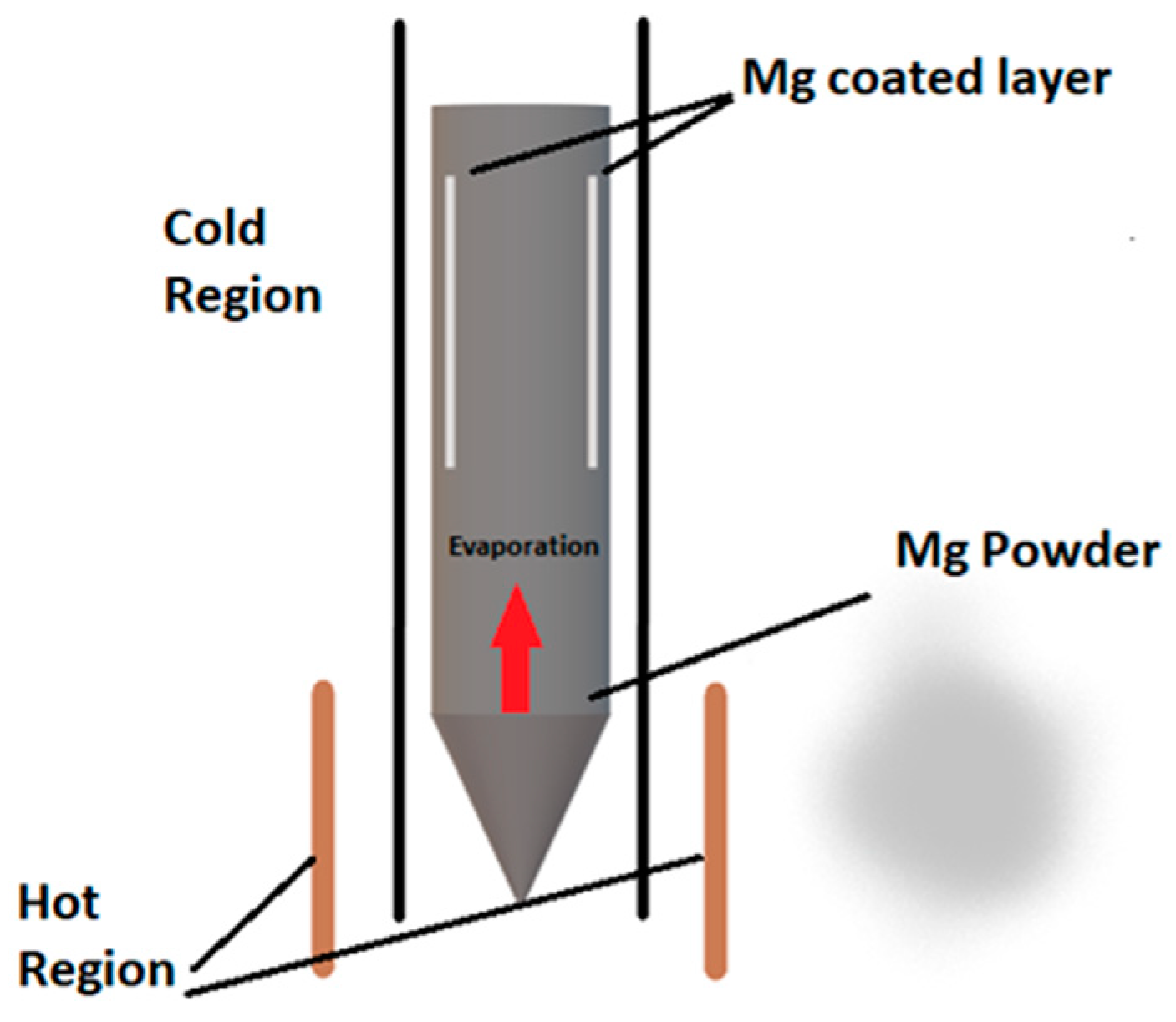
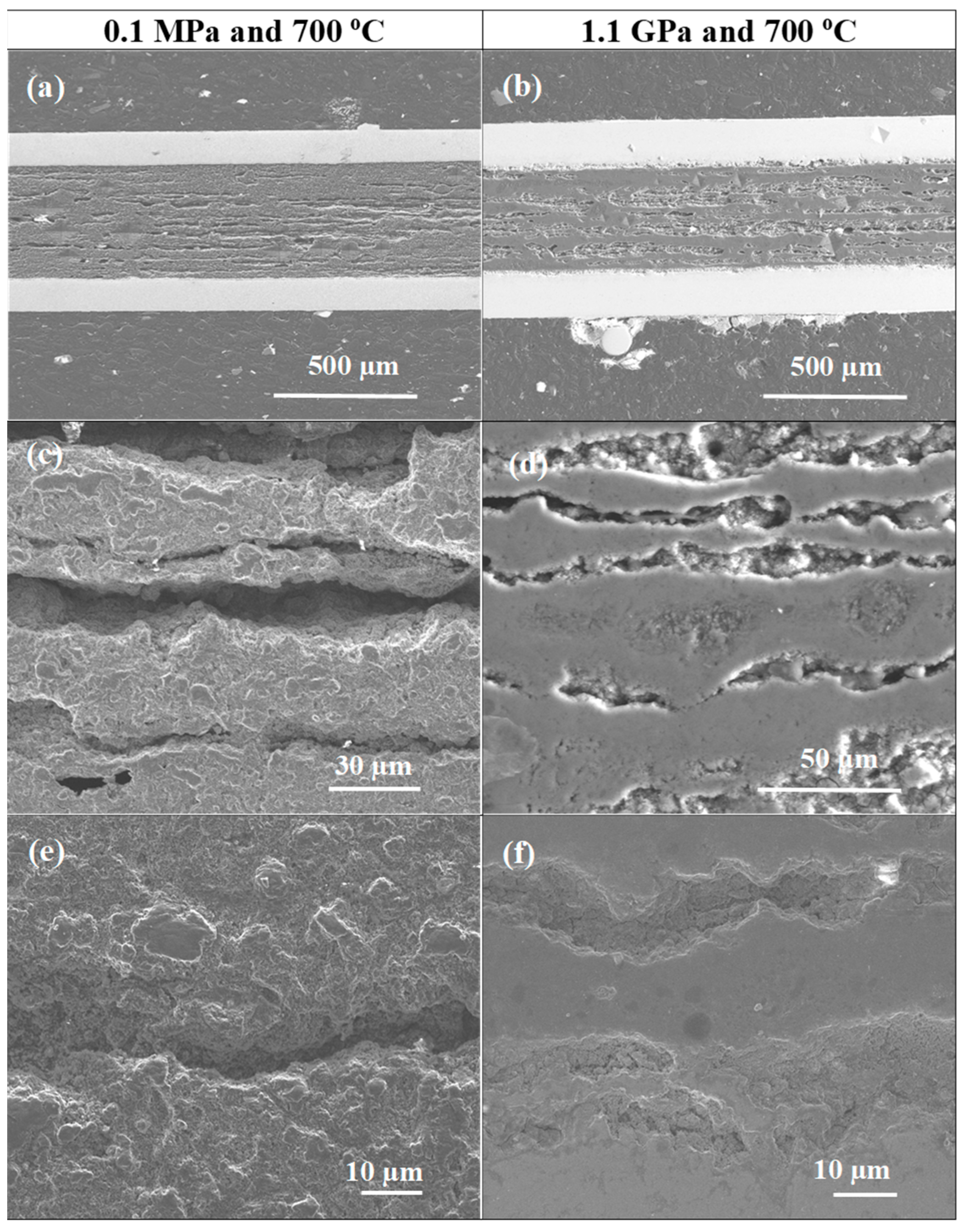
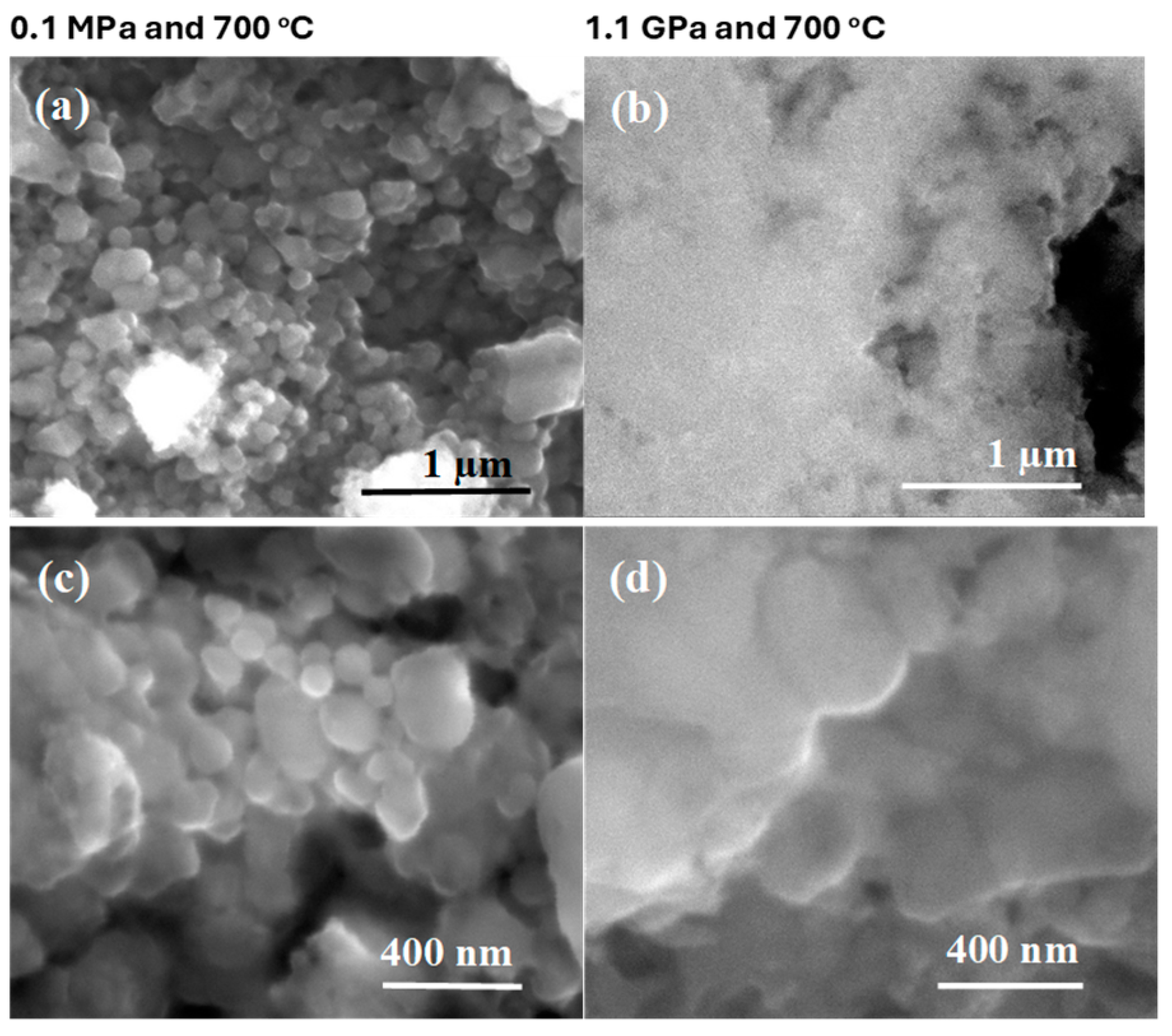



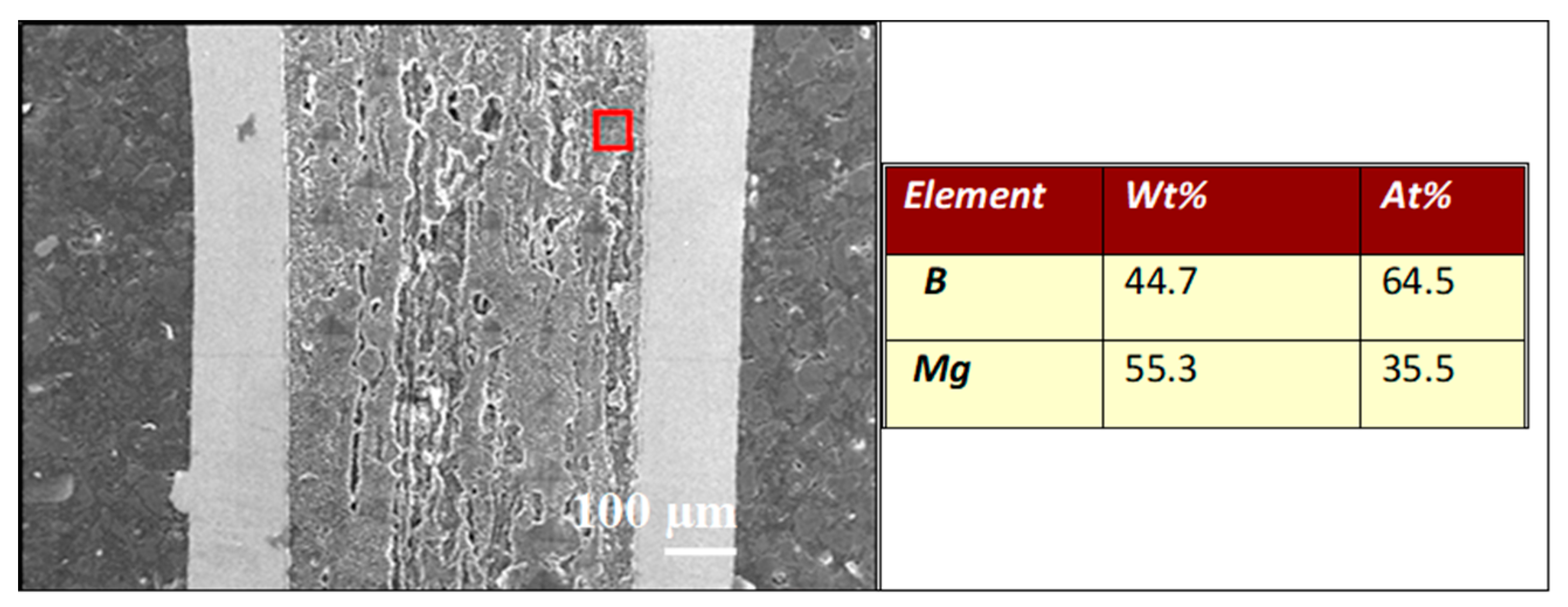

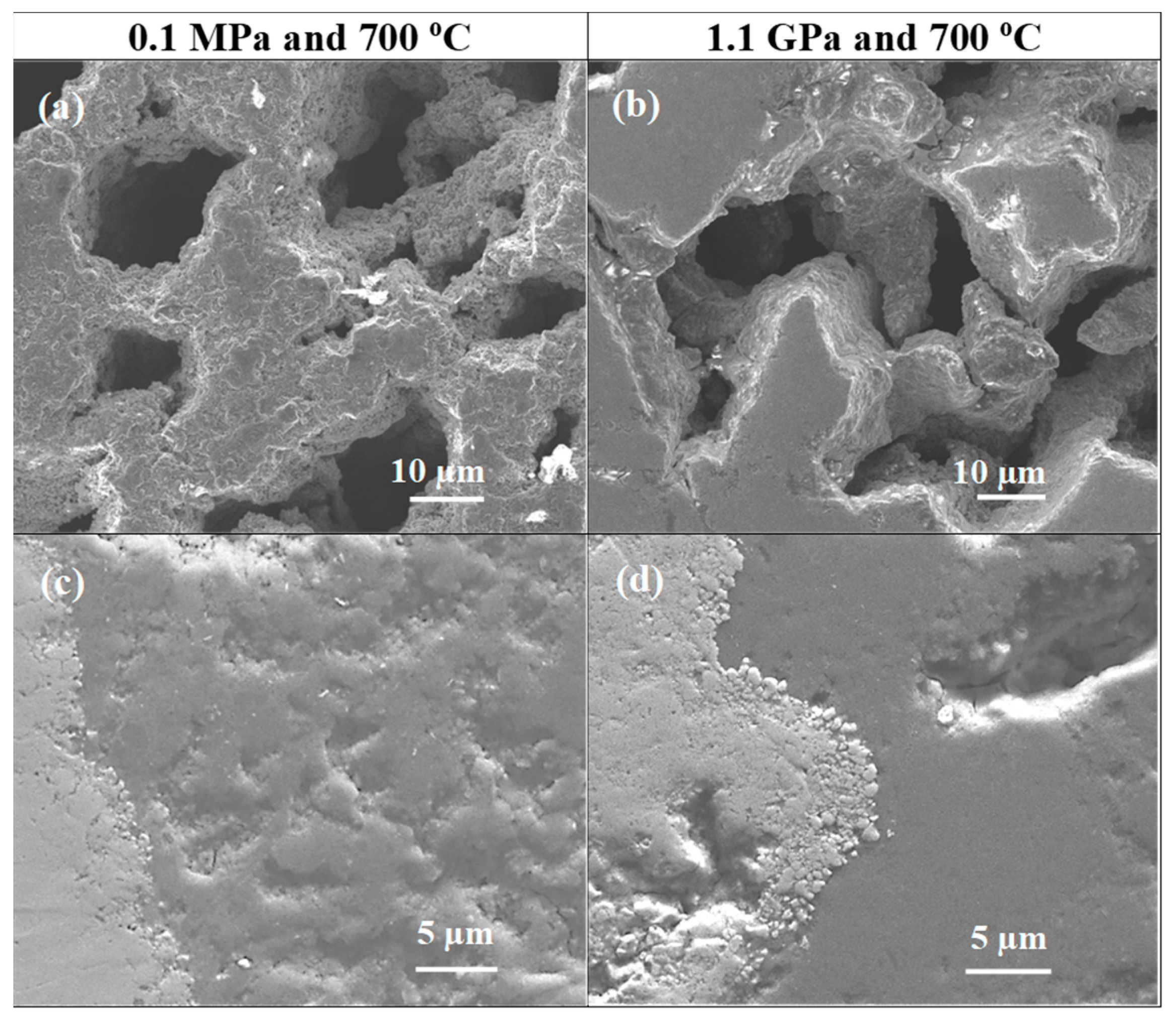

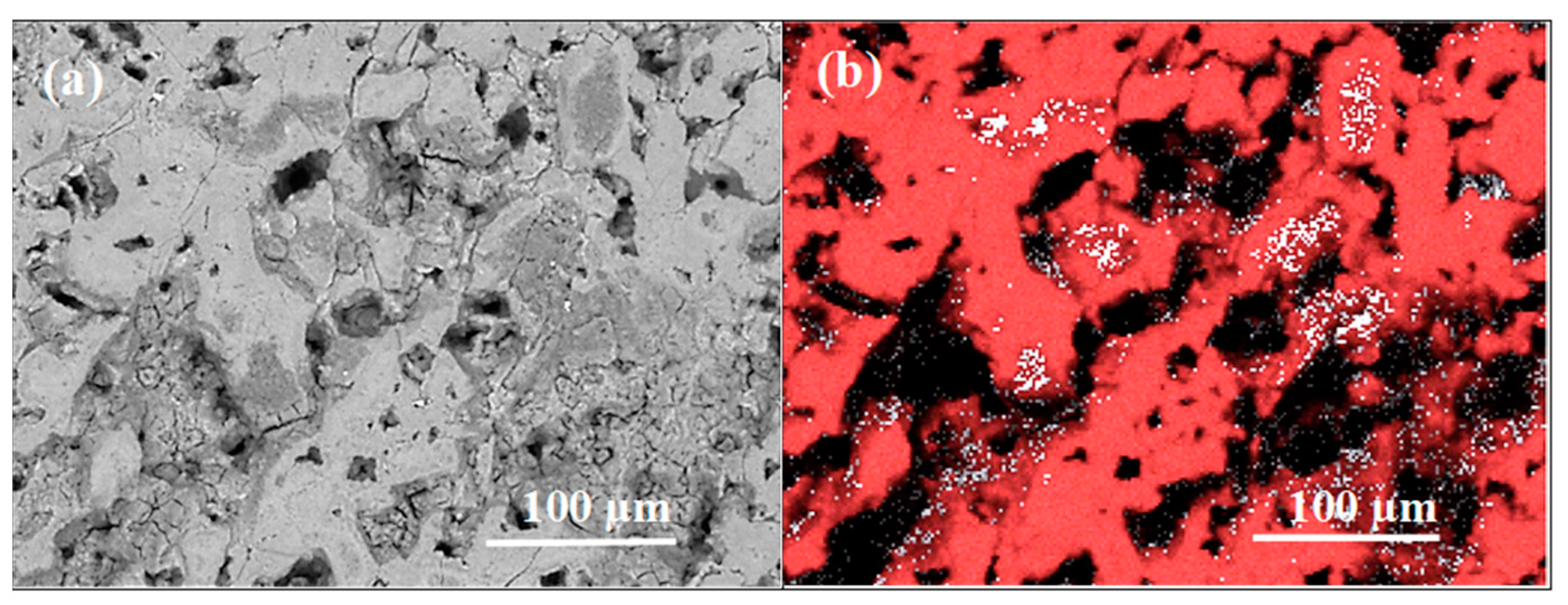
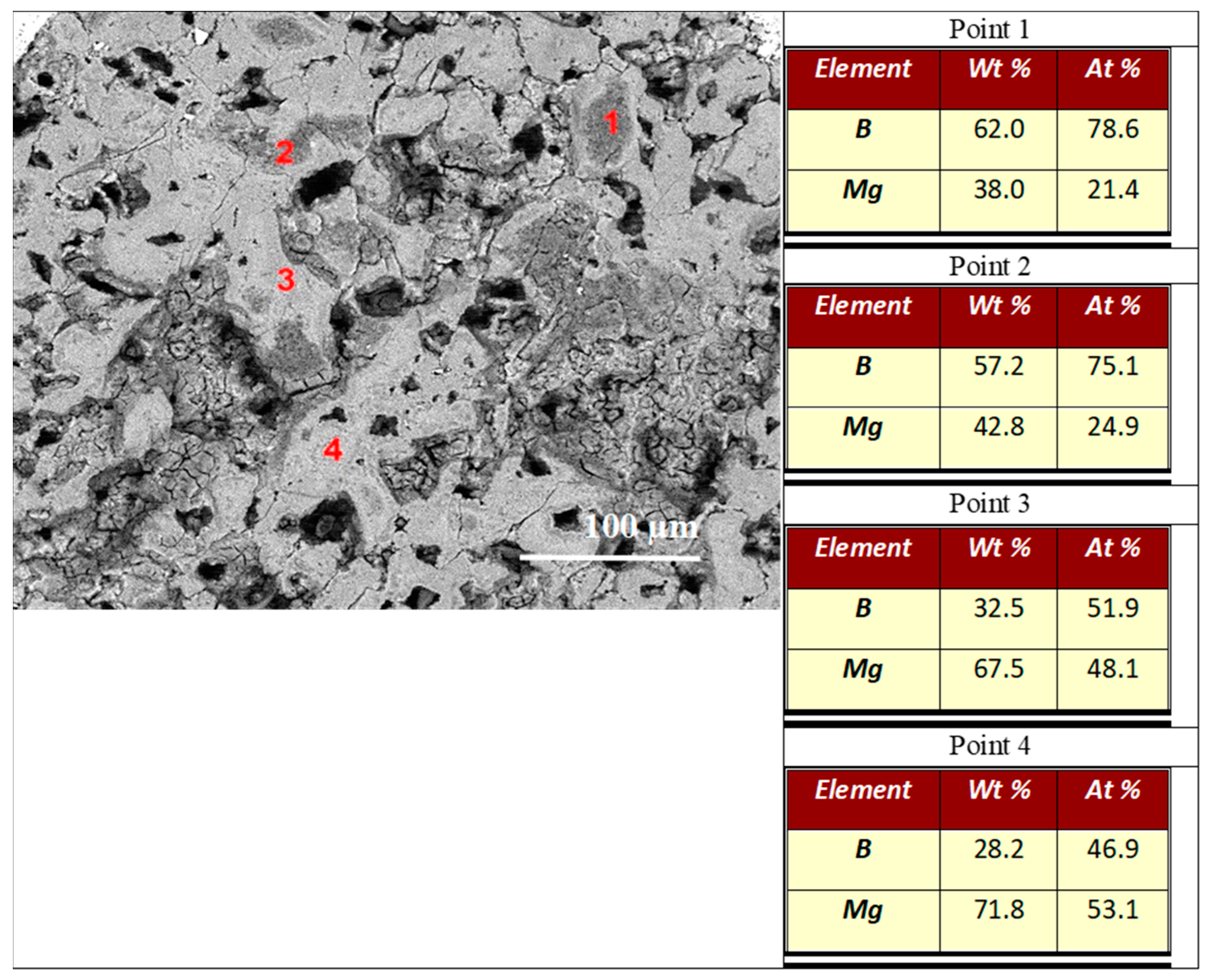
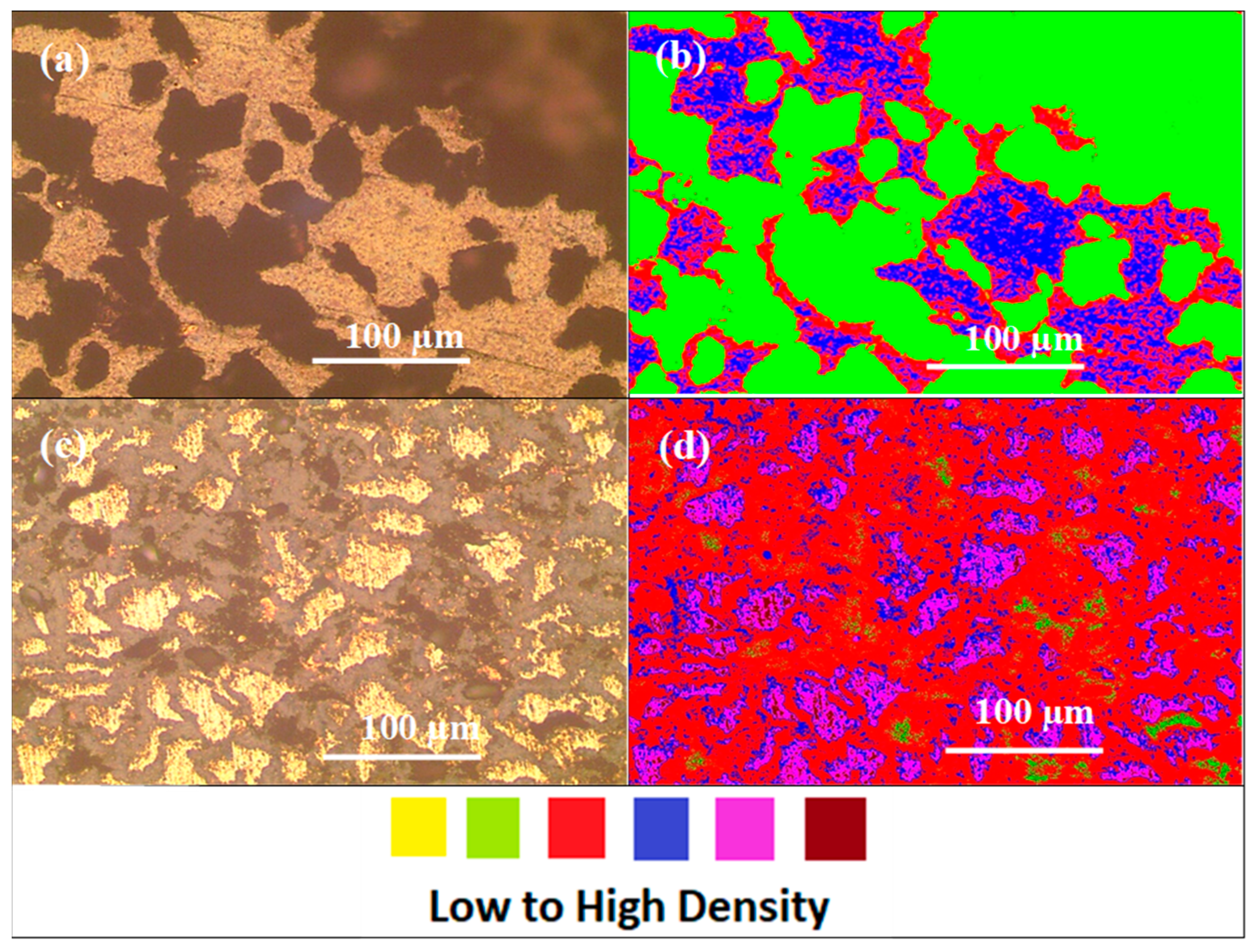
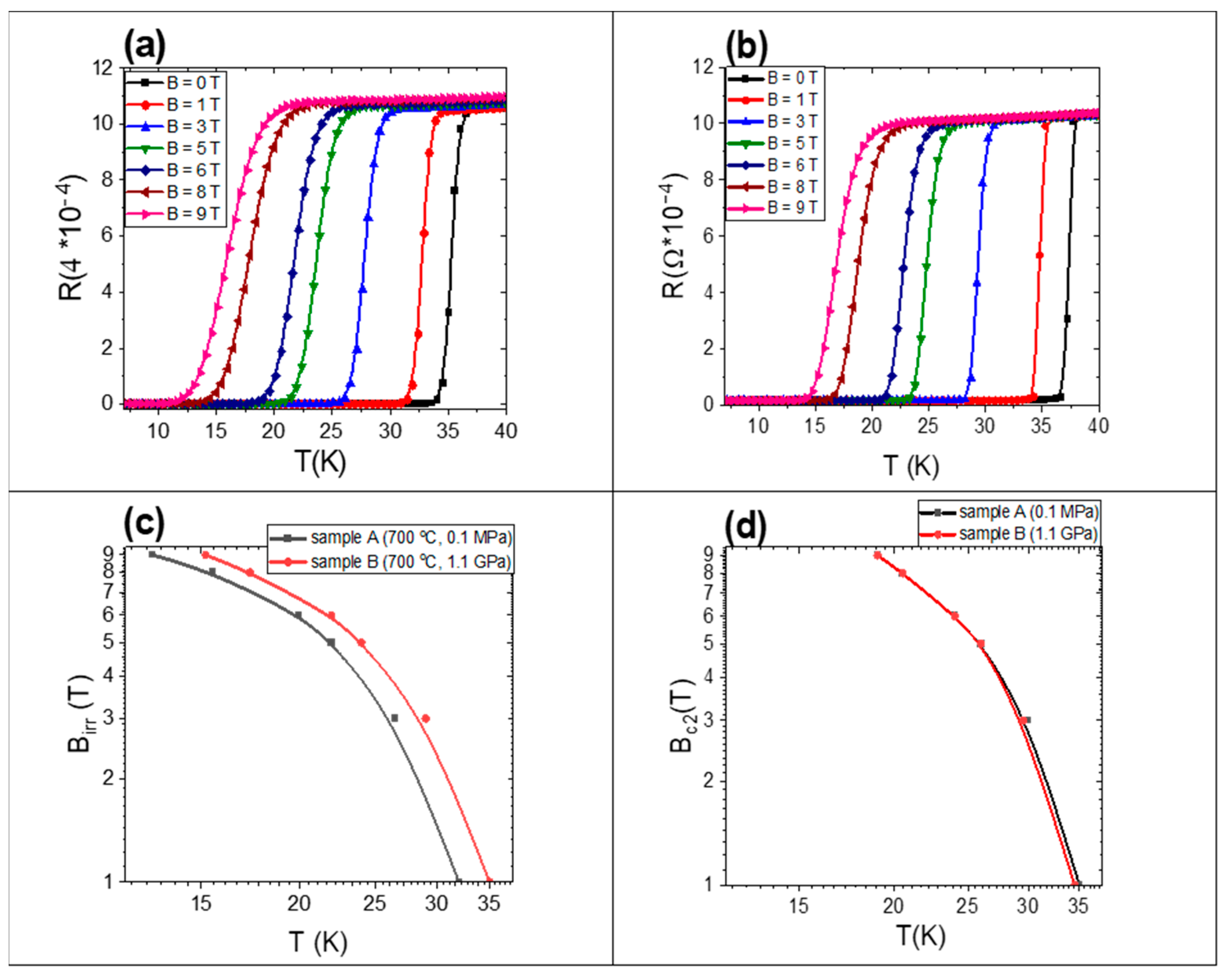
| Sample No. | Pressure [MPa] | Annealing Temperature [°C] | Annealing Time [min] |
|---|---|---|---|
| A | 0.1 | 700 | 40 |
| B | 1100 | 700 | 40 |
Disclaimer/Publisher’s Note: The statements, opinions and data contained in all publications are solely those of the individual author(s) and contributor(s) and not of MDPI and/or the editor(s). MDPI and/or the editor(s) disclaim responsibility for any injury to people or property resulting from any ideas, methods, instructions or products referred to in the content. |
© 2024 by the authors. Licensee MDPI, Basel, Switzerland. This article is an open access article distributed under the terms and conditions of the Creative Commons Attribution (CC BY) license (https://creativecommons.org/licenses/by/4.0/).
Share and Cite
Gajda, D.; Babij, M.; Zaleski, A.; Avci, D.; Karaboga, F.; Yetis, H.; Belenli, I.; Czujko, T. Investigation of Layered Structure Formation in MgB2 Wires Produced by the Internal Mg Coating Process under Low and High Isostatic Pressures. Materials 2024, 17, 1362. https://doi.org/10.3390/ma17061362
Gajda D, Babij M, Zaleski A, Avci D, Karaboga F, Yetis H, Belenli I, Czujko T. Investigation of Layered Structure Formation in MgB2 Wires Produced by the Internal Mg Coating Process under Low and High Isostatic Pressures. Materials. 2024; 17(6):1362. https://doi.org/10.3390/ma17061362
Chicago/Turabian StyleGajda, Daniel, Michał Babij, Andrzej Zaleski, Doğan Avci, Fırat Karaboga, Hakan Yetis, Ibrahim Belenli, and Tomasz Czujko. 2024. "Investigation of Layered Structure Formation in MgB2 Wires Produced by the Internal Mg Coating Process under Low and High Isostatic Pressures" Materials 17, no. 6: 1362. https://doi.org/10.3390/ma17061362
APA StyleGajda, D., Babij, M., Zaleski, A., Avci, D., Karaboga, F., Yetis, H., Belenli, I., & Czujko, T. (2024). Investigation of Layered Structure Formation in MgB2 Wires Produced by the Internal Mg Coating Process under Low and High Isostatic Pressures. Materials, 17(6), 1362. https://doi.org/10.3390/ma17061362








